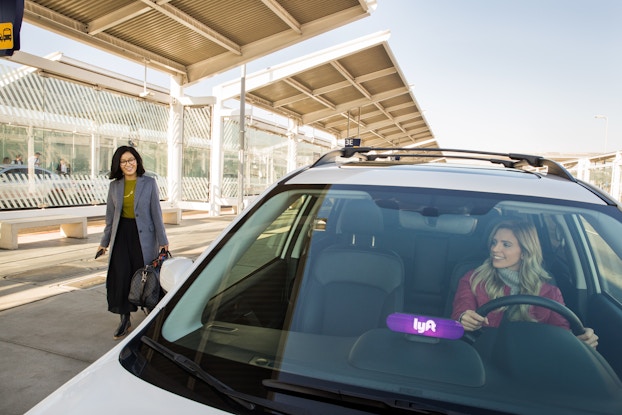
As businesses slowed to a halt as the COVID-19 pandemic spread, the ride-sharing company Lyft sped into action, according to its chief strategy officer.
Within days it had set up a task force to address the impact of the virus on its drivers and passengers and quickly launched initiatives to provide free transportation to essential workers, using Lyft drivers to deliver groceries, medicines and other essential supplies.
The pandemic “has highlighted how important a sense of urgency is,” said Lyft’s chief strategy officer, Raj Kapoor. “If your culture and your DNA is mission-driven, it’s actually a lot easier to get going because a lot of those questions about priorities become very clear in a crisis.”
Kapoor spoke about how Lyft approaches innovation, the company’s pandemic initiatives and his personal response to the crisis after contracting COVID-19 at the Accelerating Innovation and Digital Business Transformation virtual summit hosted by CDX Summits, a Techonomy Media company, attended by CO—.
The underpinning of what innovation is about is the ability to move quickly and rapidly sense what your customers want.
Raj Kapoor, chief strategy officer, Lyft
Innovation
Lyft has been adding value to essential workers and businesses in light of the coronavirus pandemic. Read on for more inspiring ways companies are contributing to the crisis efforts.
Managing so that good ideas can easily rise up
Andrew Ianni, founder/chair of CDX Summits and moderator of the discussion, said Lyft is known for innovating at warp speed.
“When Lyft has a problem that they need to solve, whether it’s a real world business problem in terms of competing against Uber, or responding to this crisis, its DNA is innovative,” Ianni told CO— after the virtual conference. “There’s no bureaucracy,” he said. “They just do it. They roll with their gut decisions.”
Lyft was able to respond quickly to the pandemic thanks to an effective “top-down, bottom-up” management style, Kapoor said.
On the top-down side of the equation, Lyft founders Logan Green and John Zimmer made it “crystal clear this is important, drop what you’re doing, take care of our community,” Kapoor said.
The bottom-up piece — having a structure where good ideas can easily rise up — is equally critical, he said.
“Where things get lost is where you have six layers of management and you just can’t get a voice heard that’s on the frontline,” Kapoor said. “The delivery team for essential deliveries was set up instantly with direct access to John Zimmer.”

A personal response to the pandemic
Kapoor also reacted swiftly when his personal experience as someone infected with COVID-19, and then as a recovered patient trying to donate plasma, made him realize the need to recruit volunteers for clinical trials.
After learning that “85% of clinical research trials are delayed due to patient recruitment,” and that 65% of the patients trying to get into trials abandon the effort because it is too complicated, he reached out to his Silicon Valley contacts with the idea of creating a COVID-19 registry to aid research. He learned that San Francisco-based Clara Health matched patients with clinical trials, and asked the company if they would provide a COVID-specific platform and make it available for free to every institution conducting trials.
Within 24 hours of receiving that request, Clara Health agreed, and “within two weeks we had the site up, worldwithoutcovid.org,” Kapoor said. As of the end of April, the site had over 800 clinical trials listed. The registry gives people, whether or not they’ve had the virus, a way to volunteer to participate in trials, and get information about donating plasma.
Prior to his current position at Lyft, Kapoor was involved in Silicon Valley startups both as an entrepreneur (he founded and later sold the online photo service Snapfish) and as a venture investor. While at venture capital firm Mayfield, he led the Series A investment round in Lyft, back when it was still called ZimRide. Kapoor joined the company as chief strategy officer in 2016, and is overseeing its self-driving cars push.

Speeding up automation
Kapoor said the current crisis could speed up adoption of self-driving cars and driverless delivery robots, as communities and consumers look to develop new forms of contactless transportation and delivery.
“We may have a situation in the future where there just aren’t enough drivers because of a pandemic or some other situation,” he said. “You’re going to rely more on automation for those critical things like transportation.”
Going forward, companies will have to weigh all decisions against the safety concerns of a consumer traumatized by the pandemic, Kapoor said.
“Even if you’re a fully virtual company, you’re still dealing with a customer that has changed their psyche,” he said.
“The underpinning of what innovation is about is the ability to move quickly and rapidly sense what your customers want,” he said. The pandemic, Kapoor said, has added a new dimension, “which is to recognize the mental state of your customer and how safety and security at its most basic level — the security of me as a human being — plays into whatever you’re doing.”
CO— aims to bring you inspiration from leading respected experts. However, before making any business decision, you should consult a professional who can advise you based on your individual situation.
Want to read more? Be sure to follow us on LinkedIn!
CO—is committed to helping you start, run and grow your small business. Learn more about the benefits of small business membership in the U.S. Chamber of Commerce, here.








